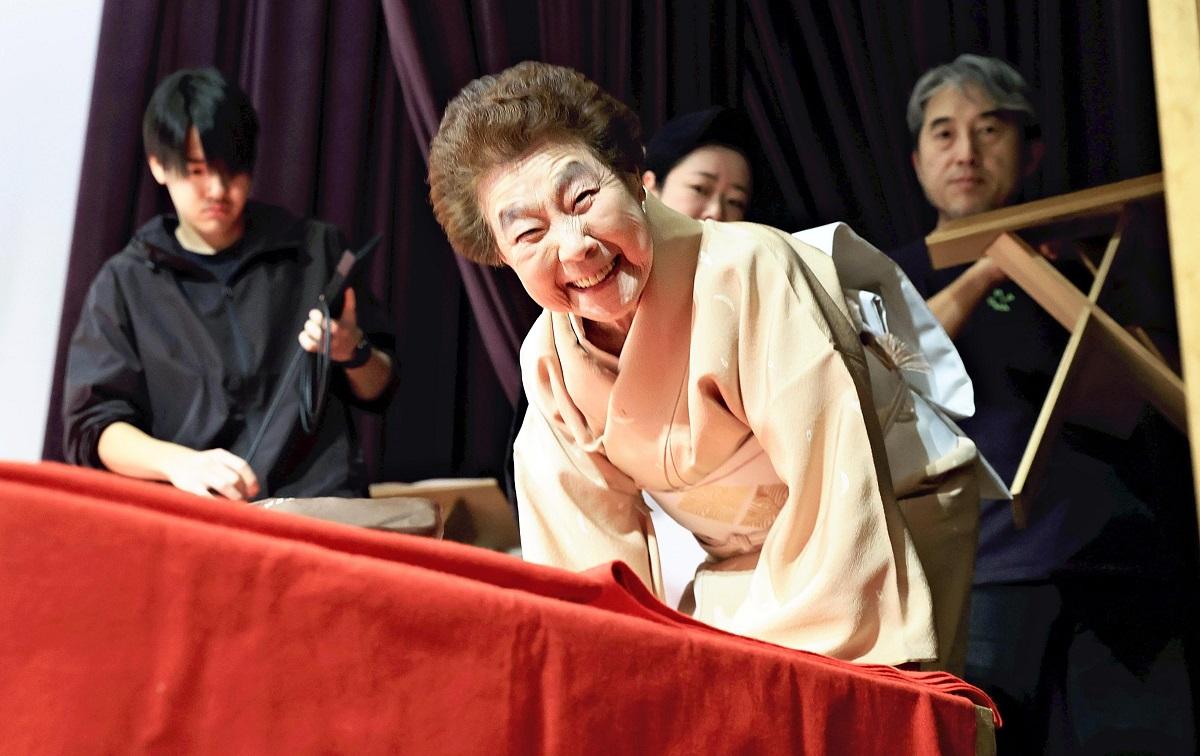Kyoto Geiko Quarters / Bond of 2 Geiko ‘Sisters’ Bridges 65-year Age Gap
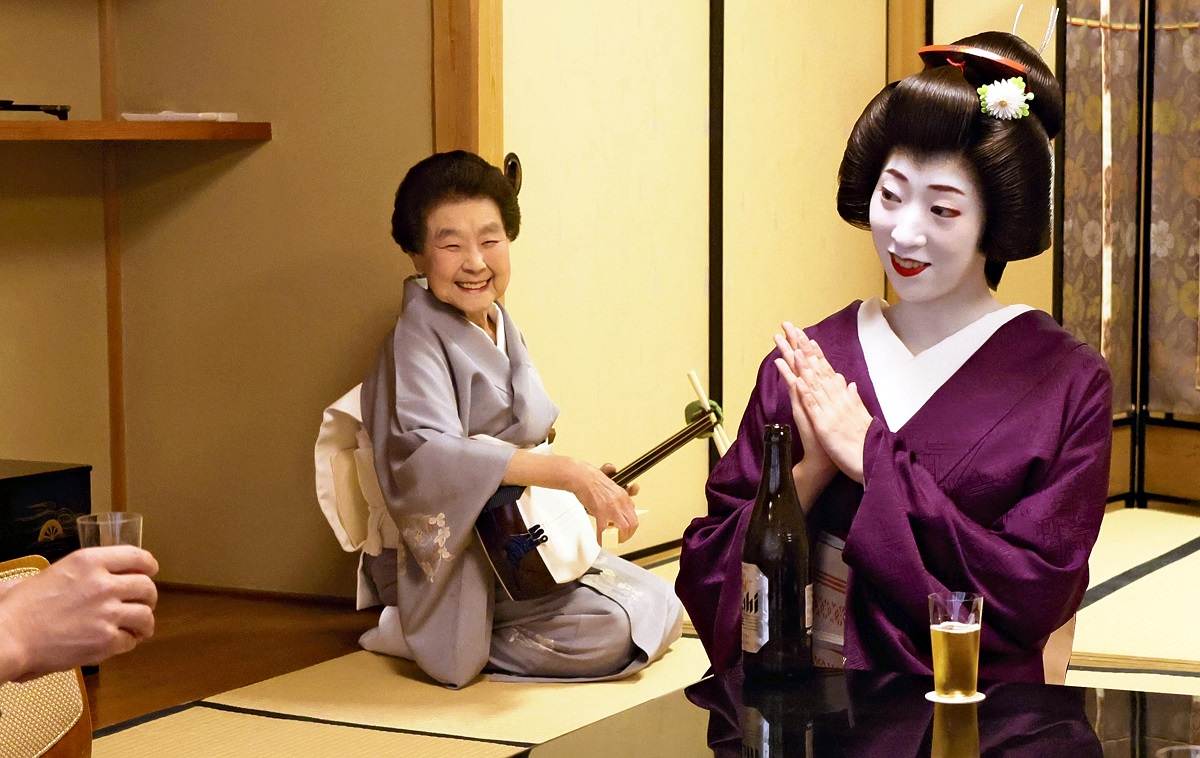
Right: Taeno, right, claps her hands at a banquet in a tatami room, with Tae looking on and smiling as she plays the shamisen, in Kyoto on Oct. 18.
By Asako Kisui / Yomiuri Shimbun Senior Writer
7:00 JST, January 2, 2024
Kyoto is home to five geiko quarters called “kagai”: Gion Kobu, Miyagawacho, Pontocho, Kamishichiken and Gion Higashi. Geiko is Kyoto’s term for a geisha. As of the end of October, there were 213 geiko and maiko (apprentice geiko) in the quarters, adding color and splendor to the ancient capital. The following is the first installment in a series that follows two women in Miyagawacho — a 91-year-old veteran and a 26-year-old who became a geiko a year ago.
***
KYOTO — In October, a special performance was held in Miyagawacho. On stage, geiko danced in fall-themed costumes, and the 91-year-old Tae sat playing the shamisen, her back straight, her knees resting on scarlet cloth.
When Tae finished her performance, she did not return to the dressing room, but instead went to the 26-year-old Taeno, who was waiting offstage, looking nervous. Tae whispered to Taeno: “Before you go onstage, bow to the stage. And when the curtain rises, take a deep breath.”
“Thank you, sister,” said Taeno. Then, for the first time, she performed kiyomoto, a type of narrative recitation.
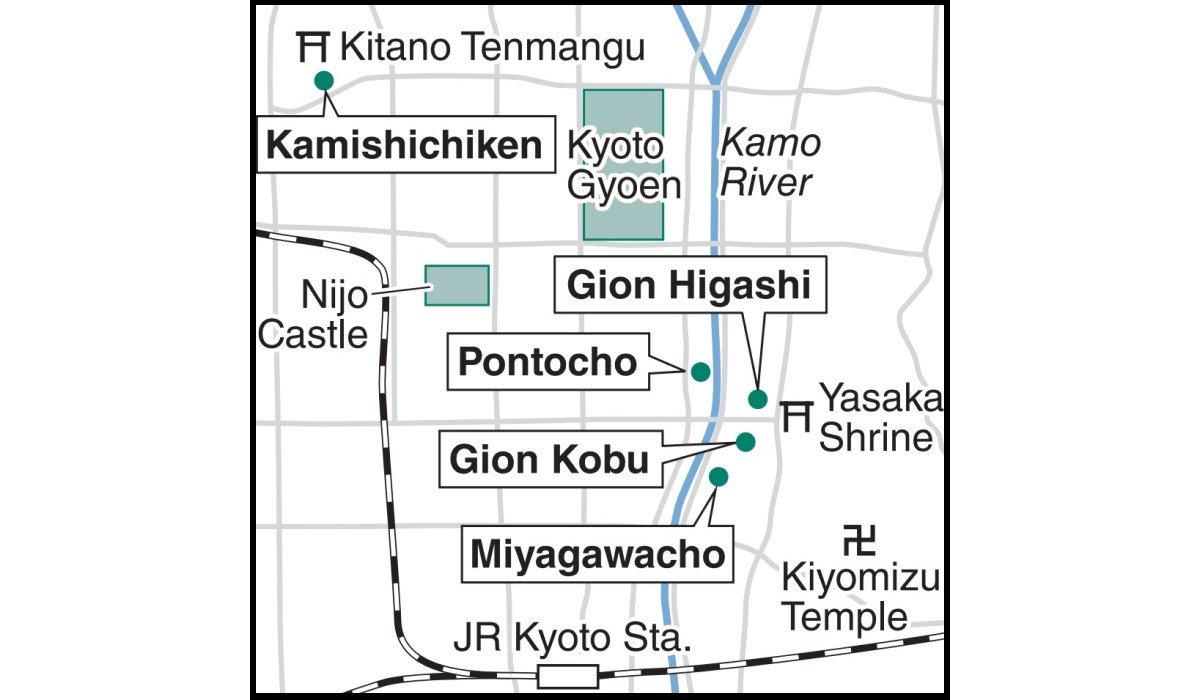
In November 2022, the year Taeno became a geiko, the two women exchanged small cups of sake in a ceremony meant to cement their bond, and in doing so became “sisters,” though one is 65 years older than the other. They were keeping alive an entertainment quarters tradition in which a new geiko or maiko and a senior geiko form a sisterly bond, the younger one takes part of the elder’s name, and the elder teaches etiquette, hospitality and fortitude.
Tae was born in Osaka. She worked as a geiko in Soemoncho, one of the five geiko quarters in the city’s Minami area, for more than 20 years. This was a time of rapid economic growth for Japan. Osaka’s high-end ryotei restaurants became hot spots for businesspersons and cultural figures. She worked hard to hone her arts and speaking skills, which still serve her well.
After retiring, Tae taught shamisen for over 40 years, but she began to feel more and more acutely her love of the geiko life. Finally, she returned to the stage at age 84, this time in Kyoto’s Miyagawacho.
Onstage and at banquets in teahouses, she plays the shamisen and sings as a jikata, a person in charge of the music for a Japanese dance performance. There are few older geiko like Tae in Kyoto’s entertainment quarters.
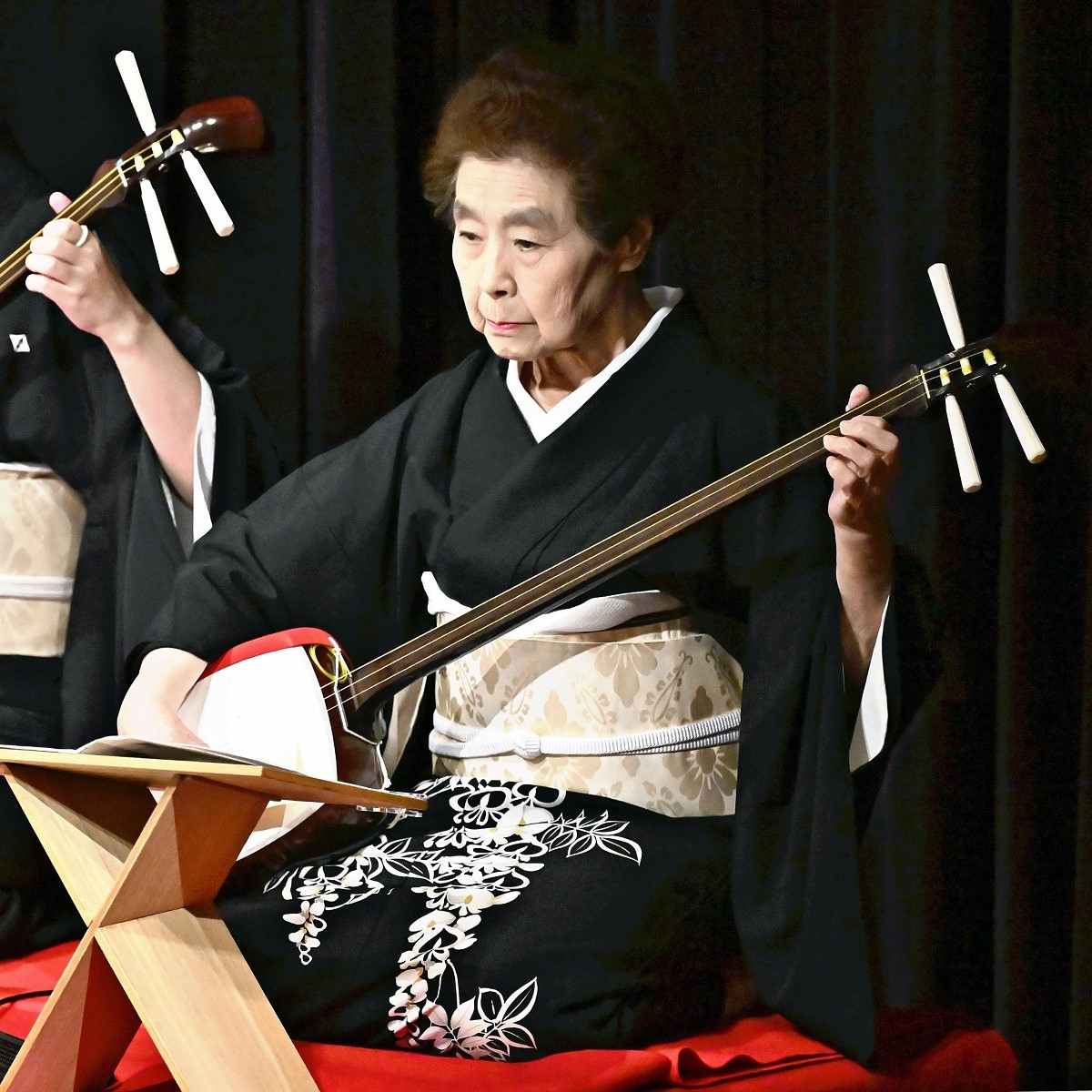
Tae plays the shamisen in Kyoto on Oct. 28.
Taeno, on the other hand, hails from Kyoto. She learned tea ceremony and dance because of her admiration for maiko. She went to university and worked for a company, but jumped into the kagai world in her mid-20s, a rarity when most girls start in their teens.
It has been a year since the two sealed their bond. They have worked together every day, performing onstage and entertaining guests at banquets.
After the October performance, Taeno told Tae, “When you gave me those words of encouragement, I felt reassured and energized, and I told myself, ‘I have to work harder.’” Tae smiled warmly at her cheerful “little sister.”
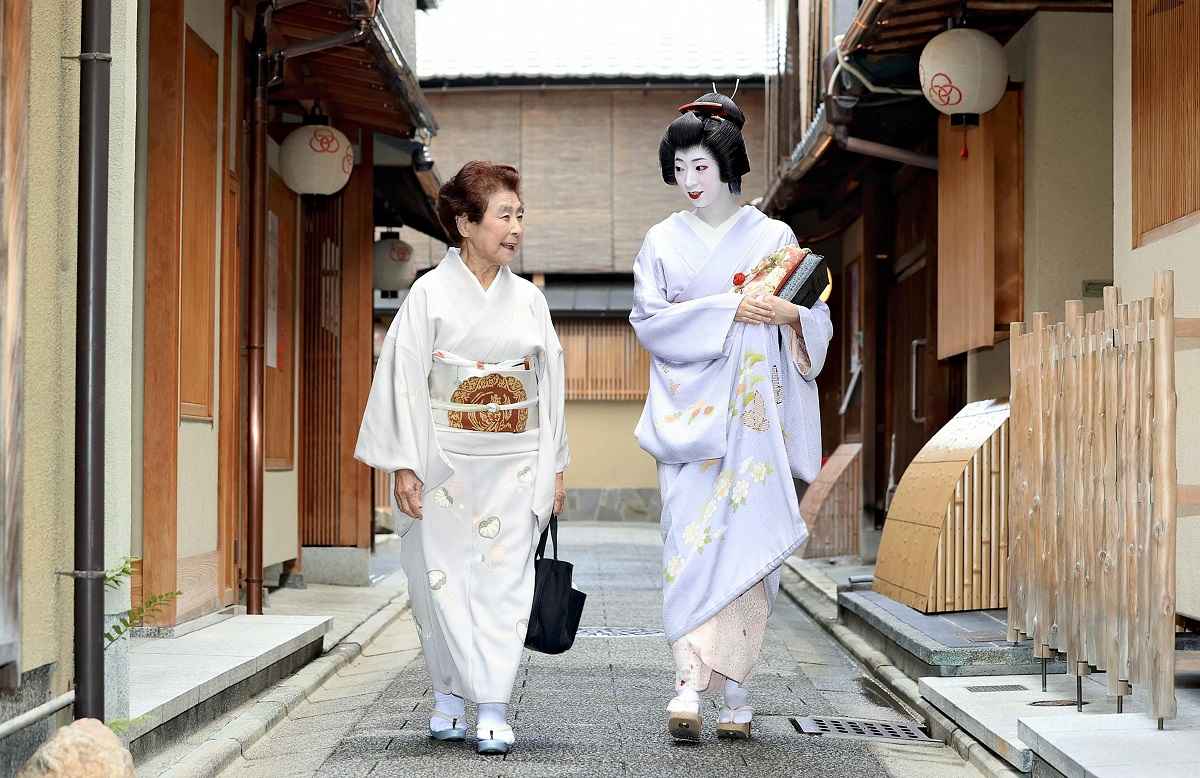
Left: Taeno, right, and Tae walk to a teahouse in Kyoto on Nov. 15.
Related Articles
Popular Articles
Popular articles in the past 24 hours
-

Nagano Pref. Village to Introduce Fines for Some Disruptive Behav...
-

Santa Claus Delivers Christmas Presents to Penguins at Aquarium i...
-

Earthquake Damage Estimates Report Highlights Challenges Faced by...
-

M5.5 Earthquake Hits Japan’s Aomori and Iwate Prefectures; No Tsu...
-

Students Recreate 19th-Century Bento Boxes Made for Ino Tadataka'...
-

Outline for Tax System Reform: Put Japan’s Economy on New Growth ...
-

My Husband is Extraordinarily Strict with our Daughter, Who is St...
-

U.S. Plans to Stop Recommending Most Childhood Vaccines, Defer to...
Popular articles in the past week
-

Israeli Tourists Refused Accommodation at Hotel in Japan’s Nagano...
-

Tsukiji Market Urges Tourists to Avoid Visiting in Year-End
-

China to Impose Sanctions on Shigeru Iwasaki, Former Head of Japa...
-

U.S. Senate Resolution Backs Japan, Condemns China's Pressure
-

Japan to Support Central Asian Logistics Route That Bypasses Russ...
-

Speed Skater Yukino Yoshida Clinches Ticket to Milan
-

Kenta Maeda Joins Rakuten Eagles; Returns from American MLB to Ja...
-

Sharp Decline in Number of Chinese Tourists But Overall Number of...
Popular articles in the past month
-

Keidanren Chairman Yoshinobu Tsutsui Visits Kashiwazaki-Kariwa Nu...
-

Imports of Rare Earths from China Facing Delays, May Be Caused by...
-

University of Tokyo Professor Discusses Japanese Economic Securit...
-

Japan Pulls out of Vietnam Nuclear Project, Complicating Hanoi's ...
-

Govt Aims to Expand NISA Program Lineup, Abolish Age Restriction
-

Blanket Eel Trade Restrictions Rejected
-

Key Japan Labor Group to Seek Pay Scale Hike
-

M4.9 Earthquake Hits Tokyo, Neighboring Prefectures
"Society" POPULAR ARTICLE
-

M4.9 Earthquake Hits Tokyo, Neighboring Prefectures
-

M7.5 Earthquake Hits Northern Japan; Tsunami Waves Observed in Hokkaido, Aomori and Iwate Prefectures
-

Israeli Tourists Refused Accommodation at Hotel in Japan’s Nagano Pref., Prompting Protest by Israeli Embassy and Probe by Prefecture
-

Tsukiji Market Urges Tourists to Avoid Visiting in Year-End
-

M5.7 Earthquake Hits Japan’s Kumamoto Pref., Measuring Upper 5 Intensity, No Tsunami Expected
JN ACCESS RANKING
-

Keidanren Chairman Yoshinobu Tsutsui Visits Kashiwazaki-Kariwa Nuclear Power Plant; Inspects New Emergency Safety System
-

Imports of Rare Earths from China Facing Delays, May Be Caused by Deterioration of Japan-China Relations
-

University of Tokyo Professor Discusses Japanese Economic Security in Interview Ahead of Forum
-

Japan Pulls out of Vietnam Nuclear Project, Complicating Hanoi’s Power Plans
-

Govt Aims to Expand NISA Program Lineup, Abolish Age Restriction
